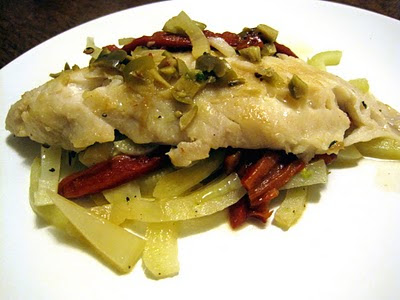We were lucky enough to find these pork tenderloins at a local meat shop in Ohio, where my parents live. It's a great spot - the meat is butchered right there on the premises, and you can watch the process through big glass windows! (This may not be a plus for everyone, but I thought it was great - and you certainly know your meat is fresh!)
Apple-Cranberry Stuffed Pork Tenderloin (adapted from Simply Recipes, original recipe here)
Serves 4
Filling
1 cup apple cider
1/2 cup cider vinegar
3/4 cup packed light brown sugar
1 large shallot, peeled, thinly sliced
1 apple, diced
1/2 cup dried cranberries
1 T grated fresh ginger
1 T yellow mustard seeds
1/2 tsp ground allspice
1/8 to 1/4 tsp cayenne pepper
Pork Roast
2 pork tenderloins, about 1-1/2 pounds total
Kosher salt and freshly ground black pepper
1. Before starting on the pork, put the pork tenderloins in the freezer for 30 minutes to make it easier to cut. While the pork is chilling, make the filling.
2. Bring all the filling ingredients to simmer in medium saucepan over medium-high heat. Cover, reduce heat to low, and cook until apples are very soft, about 20 minutes. Strain through a fine-mesh sieve, reserving the liquid. Use a rubber spatula to press against the apple mixture in the sieve to extract as much liquid out as possible. Return liquid to saucepan and simmer over medium-high heat until reduced to 1/2 cup, about 5 minutes. Remove from heat, set aside and reserve this liquid for use as a glaze. Pulse apple mixture in food processor, about fifteen 1-second pulses. Set aside.
3. Preheat oven to 350°F Place a cookie cooling rack in an 8-1/2x11 baking dish and set aside.
4. Lay one tenderloin down on a cutting board. Insert the knife into the pork 1/2-inch horizontally from the bottom of the pork, along the long side of the tenderloin. Make a long cut along the bottom of the roast, stopping 1/2 inch before the edge of the roast. You might find it easier to handle by starting at a corner of the roast. Open up the tenderloin and continue to cut through the thicker half of the pork, again keeping 1/2 inch from the bottom. Repeat until the pork is an even 1/2-inch thickness all over when laid out. If necessary, pound the pork to an even thickness with a meat pounder. Repeat with the second tenderloin.
5. Season the inside of both tenderloins well with salt and pepper. Spread out the filling evenly on the two pieces of pork, leaving a 1/2-inch border from the edges. Roll each tenderloin back up. If needed, secure with kitchen twine at 1-inch intervals (I did not need to do this). Season the outside of the pork generously with salt and pepper.6. Place tenderloins on the cookie rack, and place in oven, on the middle rack.
7. Cook for 45 to 60 minutes, until the internal temperature of the pork is 130 to 135 degrees. Brush with half of the glaze and cook for 5 minutes longer. Remove the tenderloins from the oven. Place on a cutting board. Tent with foil to rest and keep warm for 15 minutes before slicing.
8. Slice into 1/2-inch wide pieces, removing the cooking twine as you cut the roast. Serve with remaining glaze.
Delicious served with snap peas, warm potato salad, rosemary bread, and jello salad. Not pictured here is my aunt's green tomato-grape chutney, which was an excellent accompaniment.









